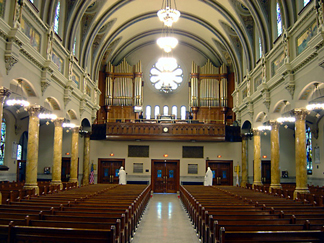(photos by Stephen StDenis)


Worcester
Chapter of the American Guild of Organists
Central Massachusetts Pipe Organ Specification Collection
Casavant-Freres, Limitee,
St. Hyacinthe, Quebec
Opus 1239, 1928
3 manuals, 29 ranks, Electropneumatic action
Composition de l'orgue
GRANDE ORGUE
Montre 8'
Principal 8'
Flute Ouverte 8'
Gemshorn 8'
Octave 4'
Flute Harmonique 4'
Trompette 8'
RECIT (Expressif)
Bourdon 16'
Bourdon 8'
Principal 8'
Viole de Gamba 8'
Voix Celeste 8'
Principal 4'
Flute Traverse 4'
Flautino 2'
Cornet 3 Ranks
Trompette 8'
Hautbois 8'
Voix Humaine 8'
POSITIF (Expressif)
Principal 8'
Melodie 8'
Dulciane 8'
Flute d'Amour 4'
Clarinette 8'
PEDALE
Flute Ouverte 16'
Bourdon 16'
Bourdon Doux 16'
Flute 8'
Flute Douce 8'
PEDALES A BASCULE
Expression Recits
Expression Positif
Crescendo
ACCOUPLEMENTS/TIRASSES
Recit au Grande Orgue 16' 8' 4'
Positif au Grande Orgue 16' 8' 4'
Recit au Positif 16' 8' 4'
Grande Orgus au Grande Orgue 4'
Recit au Recit 16' 4'
Positif au Positif 16' 4'
Grande Orgue a la Pedale 8'
Recit a la Pedale 8' 4'
Positif a la Pedale 8'
BOUTONS a DOUBLE ACTION
Grande Orgue a la Pedale
Grande Orgue a la Pedale (au Pied)
Positif a la Pedale
Recit au Grande Orgue
Positif au Grand Orgue
Recit au Positif
Grand Jeu (au Pied)
Rappel
BOUTONS de COMBINASIONS -AJUSTABLES
1, 2, 3 AU Grande Orgue
1, 2, 3, 4 au Recit
1, 2, au Positif
1, 2, a la Pedale
1, 2, 3 Generaux (au Pied)
INDICATEURS
Grand Jeu
Vent Metre
Voit Metre
Holy Family Parish / St Joseph's History
In the 19th century, tens of thousands of French-Canadians migrated to New England to escape the economic conditions of Québec and New Brunswick. Thousands came to Worcester and settled in different parts of the city. In the 1840s, the French-Canadians who went to church attended what was at the time the only Catholic church in Worcester. They were not comfortable there as a small minority amongst the Irish, with services in English instead of their native French.
In time, four parishes were built to serve the cultural community of French-Canadians in Worcester – Notre-Dame-des-Canadiens (1869), Saint Joseph (1891), Holy Name of Jesus (1893), and Saint Anthony of Padua (1902). Throughout the second half of the 19th century and the first half of the 20th century, these parishes grew and flourished because waves of migration from Québec and the Canadian Maritimes. They expanded, built new churches and schools. Each parish provided a spiritual home as well as a cultural epicentre for parishioners.
The present Saint Joseph Church built (1926 -1928) was designed by architect and native son Onesime Nault. The Romano- Byzantine style of ecclesial architecture was very much in vogue in French Canada at the turn of the 20th century. This had a strong influence on the building design and decoration of Saint Joseph Church. Some alterations to the interior were made in the 1970’s to reflect changes in the liturgy however most of Nault’s design remains.
During construction of St. Joseph Church the parish contracted with Casavant Frères of Saint-Hyacinthe Québec to build a pipe organ to be installed in the new church. It was common for Franco-American parishes to have a pipe organ built by a Canadian builder. The organ opus 1239 of the firm was installed for the opening of the church. The tonal character of the organ while consistent with the North American aesthetic of the time blends American, English, and French organ tonal ideals. The foundation stops combined with the reed stops make the organ particularly effective for French music of the Romantic period. To this day the organ remains essentially in its original tonal state.
By the end of the 20th century, assimilation and migration changed the cultural landscape of Worcester. By 1992, the French Masses were no longer celebrated. In addition, the shortage of priests and the costs associated with maintaining the church buildings made the case for merging of parishes . In 1974 Saint Anthony Parish was merged with Notre-Dame. In 1992 Saint Joseph Parish was merged with Notre –Dame to become Notre Dame-St. Joseph Parish. Initially, Saint Joseph Church was closed and not used for a period of time. (1992-1996). A long and intensive effort to reopen St. Joseph Church was undertaken resulting in the reopening of the church. By 2008, the two parishes Holy Name and Notre-Dame- Saint Joseph were merged into one parish at Saint Joseph Church – the Holy Family Parish.
While there is a strong connection with French-Canadian history and culture, today’s parish reflects a diversity seen throughout the city. Holy Family Parish is a thriving community with a variety of ministries and activities. Today, we are the beneficiaries of the hard work and sacrifices of the pastors and parishioners who built the original four parishes. We continue the mission of devotion to the Holy Family, service to God and our community, and sustaining a viable faith community for future generations.
(photos by Stephen StDenis)



